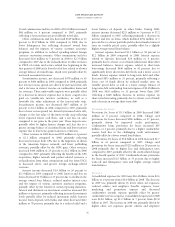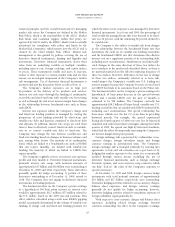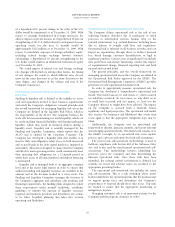American Express 2009 Annual Report Download - page 45
Download and view the complete annual report
Please find page 45 of the 2009 American Express annual report below. You can navigate through the pages in the report by either clicking on the pages listed below, or by using the keyword search tool below to find specific information within the annual report.2009 FINANCIAL REVIEW
AMERICAN EXPRESS COMPANY
Securitization of the Company’s cardmember loans
generated under designated consumer lending accounts is
accomplished through the transfer (as a sale) of cardmember
loans to the Lending Trust. In a securitization structure like
the Lending Trust (a revolving master trust), credit card
accounts are selected and the rights to the current
cardmember loans, as well as future cash flows related to the
corresponding accounts, are transferred to the Trust for the
life of the accounts.
Since the third quarter of 2007, the Company has typically
been retaining some or all of subordinated securities issued as
part of a transaction, due to prevailing market conditions.
Under the respective terms of the Lending Trust and the
Charge Trust agreements, the occurrence of certain events
could result in payment of trust expenses, establishment of
reserve funds, or in a worst-case scenario, early amortization
of investor certificates. For additional information about the
Company’s asset securitizations that could affect the
Company’s liquidity position, including three-month average
excess spread rates and other key metrics, refer to Note 7 to
the Consolidated Financial Statements.
On March 3, 2009, the Treasury Department and the
Federal Reserve launched the Term Asset-Backed Securities
Loan Facility (TALF), which is currently set to expire on
March 31, 2010. Securitized credit and charge card receivables
are eligible collateral under the TALF, provided the securities
qualify for AAA ratings from two or more major nationally
recognized statistical rating organizations (NRSROs). The
Company issued $2.25 billion in AAA rated TALF eligible
securities during 2009.
In an effort to address the concerns of the Credit Rating
Agencies and the decline in the trust excess spread due to the
performance of the underlying credit card receivables in the
Lending Trust and the related American Express Credit
Account Secured Note Trusts (the “Note Trusts”), the
subsidiaries of the Company that are the transferors of the
Lending Trust undertook certain actions during the second
quarter of 2009 to adjust the credit enhancement structure of
substantially all of the then outstanding series of securities
previously issued by the Lending Trust and the Note Trusts.
The actions entailed the issuance of two new series of asset-
backed securities, to provide additional credit enhancement
to substantially all of the then outstanding series, and the
exercise of a discount option with respect to new principal
receivables arising in the Lending Trust. The Company
believes that these actions will not have a material impact on
the Company’s results of operations. These actions resulted in
the inclusion of the Lending Trust’s assets as risk-weighted
assets for regulatory capital purposes. For additional
information regarding such actions, see Note 7 to the
Consolidated Financial Statements.
The Credit Rating Agencies are assessing the potential
impact of the adoption of recently issued accounting
standards for transfers of financial assets and for
consolidation of variable interest entities (the “Accounting
Standards”) on credit ratings of the securities issued by
securitization trusts within the overall asset-backed securities
market. (The Accounting Standards, previously issued as
FASB Statements Nos. 166 and 167, are discussed further in
Note 1 to the Consolidated Financial Statements.) In
particular, the Credit Rating Agencies are assessing the FDIC’s
safe harbor rule relating to the FDIC’s treatment of
securitized assets in the event of a sponsoring financial
institution’s receivership or conservatorship. Pursuant to the
safe harbor rule, the FDIC will not reclaim any financial asset
transferred in connection with a securitization, provided that
such transfer meets all conditions for GAAP sale accounting.
Because the adoption of the Accounting Standards may cause
some asset transfers to securitization trusts to no longer be
deemed asset sales for accounting purposes within a
company’s consolidated group, the Credit Rating Agencies
have indicated that they may ultimately conclude that the safe
harbor no longer applies and, in certain cases, that the highest
rating an asset-backed security (ABS) could receive would be
based on the sponsoring bank’s unsecured debt rating, rather
than relying on their separate evaluation of the securitization
trust. Accordingly, the ability of the Company’s securitization
programs to receive or maintain AAA ratings on ABS
securities under the same terms and conditions as it has done
in the past, or at all, is subject to uncertainty. Any action by
the rating agencies as described above could adversely impact
the Company’s ability to utilize ABS as a source of funding for
its business.
LIQUIDITY STRATEGY
The Company seeks to ensure that it has adequate liquidity in
the form of cash and readily-marketable securities easily
convertible into cash, to satisfy all maturing funding
obligations for a 12 month period, in addition to having
access to significant additional contingent liquidity sources.
This objective is managed by regularly accessing capital
through a broad and diverse set of funding programs, by
maintaining a portfolio of cash and readily-marketable
securities, as well as a variety of contingent sources of cash
and financing. The Company maintains a liquidity plan that
enables it to continuously meet its financing obligations even
when access to its primary funding sources become impaired
or markets become inaccessible.
In addition to its cash and readily-marketable securities,
the Company continues to maintain a variety of contingent
liquidity resources, such as access to secured borrowing from
the Federal Reserve Bank of San Francisco through the
Federal Reserve discount window and committed bank credit
facilities.
As a result of the Company’s funding activities during
2009, the Company raised funds that substantially exceeded
its 2009 funding needs. The excess increased the amount of
cash and readily-marketable securities the Company holds.
43
























